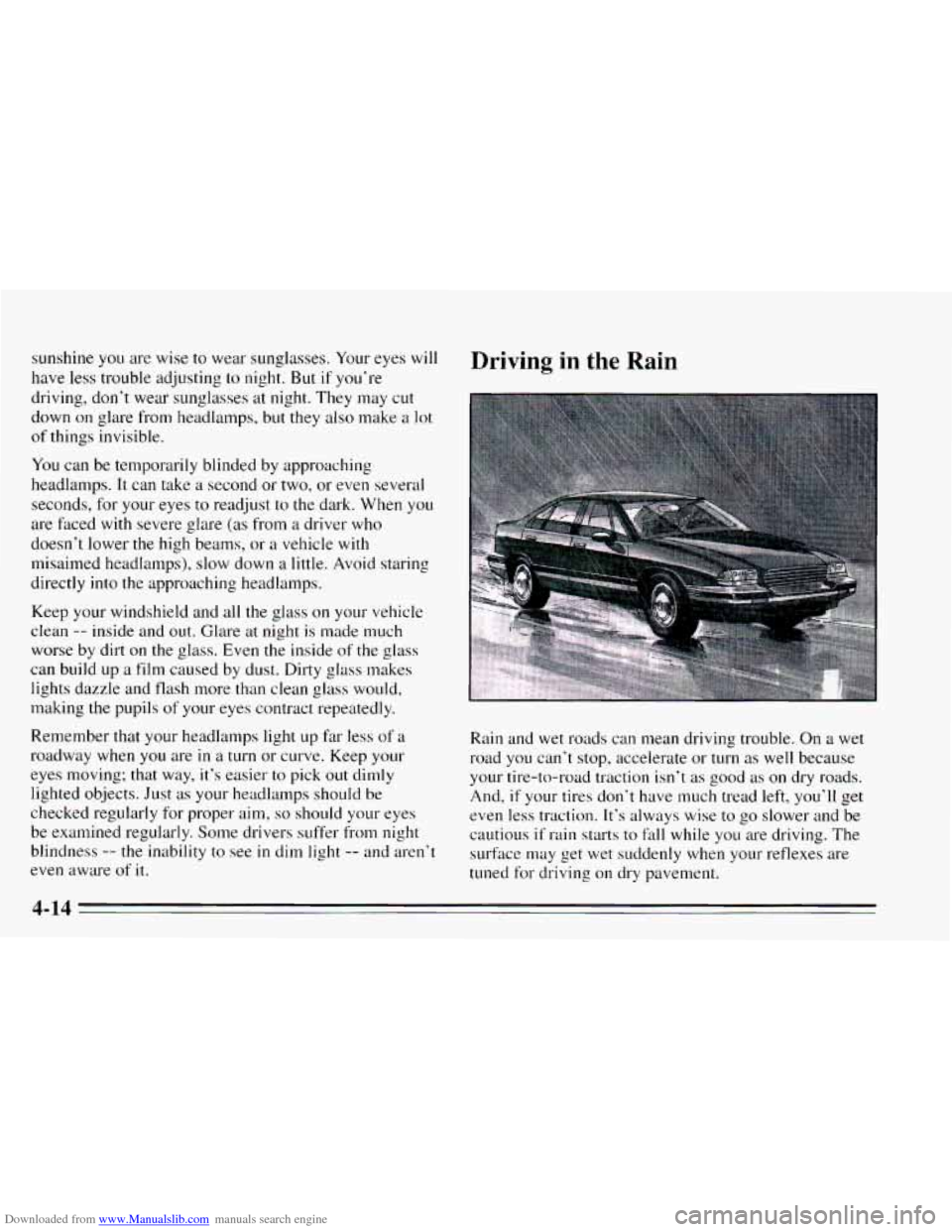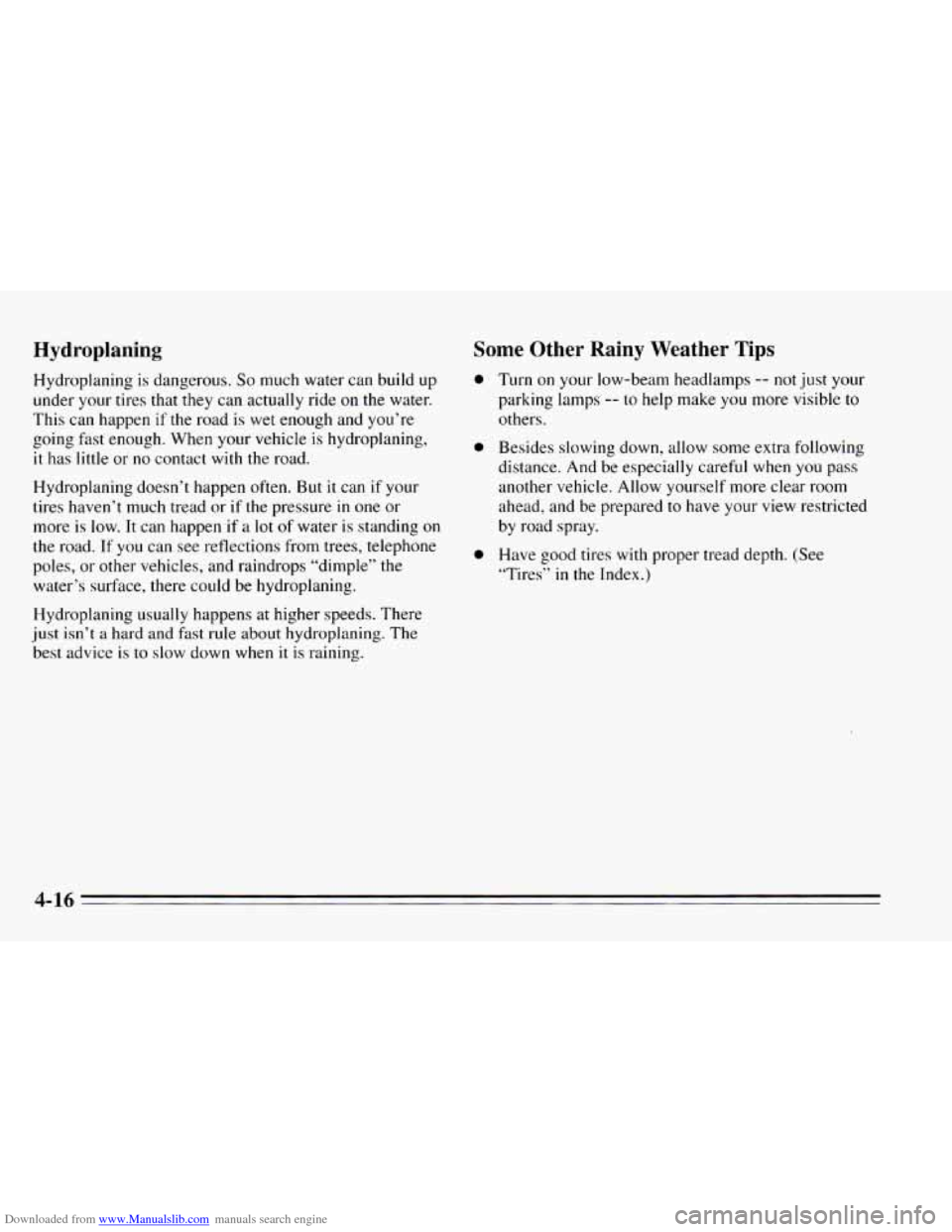Page 10 of 340

Downloaded from www.Manualslib.com manuals search engine Vehicle Symbols
These are some of the symbols you may find on your vehicle.
For example,
these symbols are used on an
original battery:
POSSIBLE A
CAUTION
INJURY
PROTECT EYES BY
SHIELDING
Q
CAUSTIC
ACID COULD BATTERY
CAUSE
BURNS
AVOID
SPARKS
OR
FLAMES
SPARK
OR ,\I/,
COULD FLAME
EXPLODE BATTERY
These symbols
are important
for you and
your passengers
whenever your
vehicle is
driven:
DOOR LOCK
UNLOCK
FASTEN SEAT
4
BELTS
POWER
WINDOW
These symbols have to
do with
your lights:
SIGNALS 6
TURN
HIGH
LAMPSoR BEAM = =o
FOG LAMPS $0
These symbols
are on
some of
your controls:
WINDSHIELD
WIPER
i i
WINDSHIELD
WASHER I
WINDSHIELD DEFROSTER
WINDOW
DEFOGGER
VENTILATING FAN
These symbols are used on
warning and
indicator lights:
COOLANT F-
ENGINE
TEMP
--
CHARGING I-1
BATTERY SYSTEM
BRAKE
(0)
RADIATOR COOLANT
a
FUEL
ENGINE OIL
PRESSURE
Wb
TEMP OIL &
ANTI-LOCK (@)
BRAKE
Here are some
other symbols
you may
see:
FUSE
RELEASE
a
RADIO
VOLUME
CONDITIONING
AIR 43
LIGHTER HORN
)b.
SPEAKER
b
viii
Page 84 of 340
Downloaded from www.Manualslib.com manuals search engine Horn
You can SOM~ the horn by pressing the center of your
steering wheel.
Tilt Steering Wheel (Option)
Turn SignaVMultifunction Lever
A tilt steering wheel allows you to adjust the steering
wheel before you drive. You can
also raise it to the
highest level to give your legs more room when
you exit
and enter the vehicle.
To tilt the wheel, hold the steering wheel and pull the
lever. Move the steering wheel to
a comfortable level,
then release the lever to lock the wheel in place. The
lever
on the left side of the steering column
includes your:
0 Turn Signal and Lane Change Indicator
0 Headlamp High-Low Beam Changer
0 Cruise Control (Option)
2-28
Page 86 of 340
Downloaded from www.Manualslib.com manuals search engine Headlamp High-Low Beam Changer
. ..
To change the headlamps from low beam to high or high
to low, pull the turn signal lever all the way toward you.
Then release it.
When
the high beams are on, a blue light on the
instrument panel also
will be on.
Flash-To-Pass
This feature lets you use your high beam headlamps to
signal a driver in front of you that you want to pass.
To use it, pull the turn signal/multifunction lever toward
you until the high beam headlamps come on, then
release the 'lever to turn them off.
Windshield Wipers
You control the windshield wipers by moving the stalk
with the windshield wiper symbol
on it up or down.
2-30
Page 94 of 340
Downloaded from www.Manualslib.com manuals search engine Instrument Panel Intensity Control Daynme Running Lamps (Canada Only)
You can brighten or dim the instrument panel lamps by
turning the dial up
or down.
Turn the dial up all the way
to turn on the interior
courtesy lamps. Daytime Running Lamps (DRL) can make
it easier for
others
to see the front of your vehicle during the day.
DRL can be helpful
in many different driving
conditions, but they can be especially helpful in the
short periods after dawn and before sunset. Several
countries, including Canada, require DRL.
The DRL system will make your high beam headlamps
come
on at a reduced brightness in daylight when:
0 The ignition is on,
0 The headlamp switch is off,
0 The parking brake is released and
On vehicles with automatic transaxles the shift lever
is moved from PARK
(P).
2-38
~~ -.
Page 95 of 340
Downloaded from www.Manualslib.com manuals search engine This indicator light on your
instrument panel comes
on
when DRL are on. When
you turn
off the headlamp switch, the regular
lamps will
go off, and your high beam headlamps will
come on
to the reduced brightness.
To idle your vehicle with the DRL off, set the parking
brake. The
DRL will stay off until you release the
parking brake.
As with any vehicle, you should turn on the regular
headlamps system when you need it.
When the
DRL are on, only your high beam headlamps
will be on at a reduced brightness. The taillamps,
sidemarker and other lamps won’t be
on. Your
instrument panel won’t be lit up either.
When
you turn on the headlamp switch, your high beam
headlamps will go out, and your headlamps will come
on. The other lamps that come
on with your headlamps
will also come
on.
Page 96 of 340
Downloaded from www.Manualslib.com manuals search engine Fog Lamps (224 Model)
Use your fog lamps for better vision in foggy or misty
conditions.
The switch
for your fog lamps is next to the instrument
panel intensity control.
Push the top of the switch to turn the
fog lamps on. Push
the bottom of the switch
to turn the fog lamps off. When
using fog lamps, the parking lamps
or low beam
headlamps must be
on.
Fog lamps will go off whenever the high beam
headlamps come on. When the high beams go off, the
fog lamps
will come on again.
Front Reading Lamps (Models with Sunroof
or Convertible Top)
These lamps are located on the rearview mirror. Turn
each one on and off by pressing its switch.
2-40
Page 154 of 340

Downloaded from www.Manualslib.com manuals search engine sunshine you are wise to wear sunglasses. Your eyes will
have less trouble adjusting to night. But if you’re
driving, don’t wear sunglasses
at night. They may cut
down on glare from headlamps, but they also make a lot
of things invisible.
You can be temporarily blinded by approaching
headlamps.
It can take a second or two, or even several
seconds, for your eyes
to readjust to the dark. When you
are faced with severe glare
(as from a driver who
doesn’t lower the high beams, or a vehicle with
misaimed headlamps), slow down a little. Avoid staring
directly into the approaching headlamps.
Keep your windshield and all the glass on your vehicle
clean
-- inside and out. Glare at night is made much
worse by dirt on the glass. Even the inside of the glass
can build up
a film caused by dust. Dirty glass makes
lights dazzle and flash more than clean glass would,
making
the pupils of your eyes contract repeatedly.
Remember that
your headlamps light up far less of a
roadway when
you are in a turn or curve. Keep your
eyes moving; that way, it’s easier
to pick out dimly
lighted objects. Just as your headlamps should be
checked regularly for proper aim,
so should your eyes
be examined regularly. Some drivers suffer from night
blindness
-- the inability to see in dim light -- and aren’t
even aware of it.
Driving in the Rain
Rain and wet roads can mean driving trouble. On a wet
road you can’t stop, accelerate or turn as well because
your tire-to-road traction
isn’t as good as on dry roads.
And,
if your tires don‘t have much tread left, you’ll get
even less traction. It‘s always wise to
go slower and be
cautious
if rain starts to fall while you are driving. The
surfxe may get wet suddenly when your reflexes are
tuned for driving
on dry pavement.
4-14
Page 156 of 340

Downloaded from www.Manualslib.com manuals search engine Hydroplaning
Hydroplaning is dangerous. So much water can build up
under your tires that they can actually ride on the water.
This can happen
if the road is wet enough and you’re
going fast enough. When your vehicle is hydroplaning,
it has little or no contact with the road.
Hydroplaning doesn’t happen often. But it can if your
tires haven’t much tread or
if the pressure in one or
more is low. It can happen
if a lot of water is standing on
the road. If you can see reflections from trees, telephone
poles, or other vehicles, and raindrops “dimple” the
water’s surface, there
could be hydroplaning.
Hydroplaning usually happens at higher speeds. There
just isn’t a hard and fast rule about hydroplaning. The
best advice
is to slow down when it is raining.
Some Other Rainy Weather Tips
0
0
0 Turn on your low-beam headlamps -- not just your
parking lamps
-- to help make you more visible to
others.
Besides slowing down, allow
some extra following
distance. And be especially careful when
you pass
another vehicle. Allow yourself more clear room
ahead, and be prepared
to have your view restricted
by road spray.
Have good tires with proper tread depth. (See
“Tires”
in the Index.)
4-16